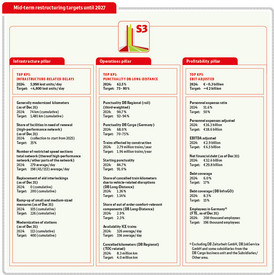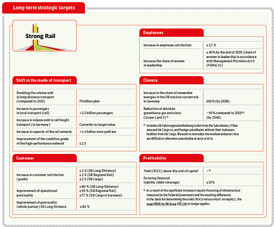S3 restructuring program
Back on track with the S3 restructuring program
We have supplemented the Strong Rail strategy with the S3 restructuring program, with which we want to improve the infrastructure, operations and profitability by 2027.
We want to improve DB Group in three key dimensions by the end of 2027:
- Infrastructure pillar: We are focusing on the rapid modernization of the existing network. This includes the general modernization of all communicated corridors by 2027 as well as other extensive measures such as the replacement of fault-prone systems across the infrastructure, the replacement of old, fault-prone interlockings or the modernization of stations.
- Operations pillar: During operations, stabilizing the schedule has the highest priority. To this end, the entire construction and maintenance system will be transferred to a so-called synchronized system, which should reduce the trains affected by construction. One aspect also focuses on the selective relief of the five most important hubs (Berlin, Hamburg, Cologne, Frankfurt and Munich). In addition, availability and quality of the vehicles are to be improved.
- Profitability pillar: In view of the economic situation, a series of measures are intended to help make DB Group more efficient again. The personnel expense ratio is to be reduced. Priority will be given to reducing staff requirements in the areas of administration, sales and indirect operational functions. This is aimed at reducing the workforce by more than 10,000 employees by 2027.There are no plans for redundancies for operational reasons, and regulations on guaranteeing employment will continue to apply. In that respect, we want to ensure that the necessary personnel are available for the operating rail business. For this reason, we have set ourselves the goal of continuing recruitment unchanged in many operational functions. As further measures to improve profitability, we want to reduce the ramp-ups of capital expenditures, particularly in the transport businesses, compared to previous plans and significantly increase profitability.
DB Group has agreed with the Federal Government to regularly report on the progress of the restructuring program. In the future, we will regularly send a set of key figures to the Supervisory Board and the Federal Ministry for Digital and Transport to document progress or identify areas where there is a need for countermeasures.
Our mid- and long-term targets

Mid-term restructuring targets
By way of the measures set out in the S3 restructuring program, we want toregain our performance. We have defined a set of key figures for each pillar of the restructuring program, which we want to use to manage transparently and to make progress visible. In summary, there is at least one key performance indicator for each pillar that provides information about the success of the restructuring program.

Long-term strategic targets
Our long-term strategic targets are based on key transport and climate policy framework conditions:
- doubling of volume sold in rail passenger transport, and
- increase rail’s market share in freight transport to 25%.
In addition, climate policy goals are supported by converting traction current to 100% renewable energies, the electrification of rail tracks and purchase of alternatively driven or hybrid-driven locomotives.
We use the relevant key performance indicators to pursue the achievement of our Strong Rail strategic targets. We refined these in 2023 and have since considered 14 DB-specific targets in the context of Strong Rail. In this way, we aim to better measure and steer the implementation status of Strong Rail even better.
Outlook: S3 restructuring program
| Anticipated development | 2024 | 2025 |
|---|---|---|
| Infrastructure pillar | ||
| Infrastructure-related delays (lost units/day) | 5,998 | 5,640 |
| Generally modernized kilometers (km) | 74 | 147 |
| Number of restricted speed sections total network (Ø/day) | 279 | 230 |
| Replacement of old interlockings (as of Dec 31) | – | 50 |
| Operations pillar | ||
| Punctuality (operational) DB Long-Distance (%) | 62.5 | 65–70 |
| Punctuality DB Regional (rail) (%) | 90.7 | 90–92 |
| Punctuality DB Cargo (Germany) (%) | 68.0 | 66.5–71.5 |
| Trains affected by construction (thousand trains/year) | 2,787 | 2,350 |
| Economy pillar | ||
| EBIT adjusted (€ billion) | –0.3 | >0 |
| Personnel expense ratio (%) | 51.6 | <53 |
- Infrastructure:
- Infrastructure-related delays are to be significantly reduced by the end of 2025 by implementing appropriate measures. The implementation of general modernizations, which has a direct impact on the quality of rail operations, is also relevant in this respect.
- In 2025, the general modernization of the Emmerich —
Oberhausen corridor will take place from February 15 to December 14. - Reducing the number of restricted speed sections is a further aspect of increasing operational quality. This is achieved by avoiding the proliferation of such sections and rapidly eliminating them, both in the high-performance network and in the other parts of the network.
- Replacing old interlockings also systematically reduces the system’s susceptibility to faults.
- Operations:
- The aim is to improve punctuality by 2025. However, achieving the punctuality targets remains a major challenge due to the further planned increase in transport volumes and the existing capacity and obsolescence problems in the infrastructure. For this reason, quality measures will be further advanced and intensified, particularly with regard to structurally sustainable improvements.
- The aim is also to reduce the trains affected by construction. A significant reduction in trains affected by construction will lower the number of construction-related regulations during the year and increase the proportion of schedule documents provided on time.
- Profitability:
- We expect to return to a positive operating profit (EBIT adjusted) in 2025. This improvement is being driven by the positive development of the transport companies and a significantly better result at DB InfraGO.
- The personnel expense ratio is likely to increase slightly compared to 2024. This is due in particular to rising personnel expenses as a result of collective wage agreements in the past and the expected moderate revenue growth.